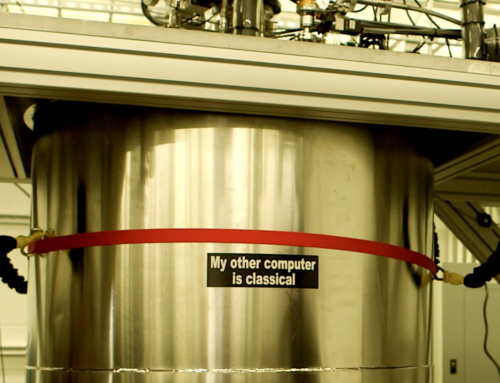With all of the recent hype about quantum supremacy, it’s easy to forget that quantum supremacy in communications was demonstrated years ago. One of the most exciting developments on the horizon for quantum communications is a quantum internet, which will securely transmit quantum information. Like most things quantum, the label of “quantum internet” has been slapped on to a quantum technological application, establishing a concept that is easily consumable for the masses, which helps to create the hype that keeps funding for that application flowing. The reality, as is often the case, is much more complex.
In fact, just about the only thing that scientists agree on is that the term “quantum internet” does not have an agreed-upon definition. That is because the technology required to manifest this reality is still in its infancy. Scientists around the world are working hard to change that. Perhaps the most well-known is Stephanie Wehner of Delft University of Technology. In preparation for the release of Project Q’s interview with Wehner on this topic, we reflect on the current stage of global development of a quantum internet.
Since 2004, the security afforded by quantum communications has been proven superior by a method known as quantum key distribution (QKD). QKD is a system employed to produce and distribute a secret key that can then be used to encode classical information. This method has since been employed by a number of actors across both private and public sectors, including banks and national security networks. It does not, however provide a secure link by which quantum information can be transmitted. Enter one important motivation for a quantum internet: to create a network of quantum nodes that enables the secure transfer of quantum information. Of course, there are a diversity of useful applications for such a network and many more still which will develop as the technology matures. One needs only to recall the history of the classical internet, for which the first projected use-value was extremely narrow, to imagine the breadth and depth of applications that will surely follow once the technology is functional.
However, a salient challenge for researchers working on a quantum internet remains. Like the classical internet, a quantum internet requires a physical infrastructure in order to function. There have been a diversity of approaches to this complex problem, from diamonds to crystals and drones to satellites. For the most part, however, the emerging dominant systems rely heavily on land-based fibre-optic cables, with some major differences between them.
In 2016 China launched their quantum satellite, Micius, as part of their Quantum Experiments at Space Scale (QUESS) project. Within a year of the satellite’s launch, major goals paving the way for a quantum internet had been achieved by a multi-disciplinary, multi-institutional team from the Chinese Academy of Sciences, led by Professor Jian-Wei Pan. These ground-to-satellite quantum communication advances included the impressive feat of establishing a quantum-secure communication spanning the longest distance yet between two different points on the globe (Beijing and Vienna) via Micius. Recently, China has also constructed the largest fibre-based quantum communication backbone, known as the Beijing-Shanghai quantum link, which stretches a distance of over 1,200 miles. However, while the link is already in use by some of China’s biggest banks to transfer sensitive data, it is not fully quantum-secure (more on that shortly).
While we have known that quantum communication is theoretically possible for some time, China has been the first country to focus its research apparatus on the challenge, building the first dedicated, large-scale infrastructure for the task. From a security perspective, this is a strategic move on China’s part. The focus on quantum communications is a pre-emptive defence mechanism to combat U.S. advances in the quantum computing space. Regardless of the development of computers, which will be capable of hacking any classical communications, a quantum-secure network will be act as a safeguard against prying eyes and ears. As a result, China continues to be a world leader in this space. However, Europe is hot on its heels and lining up to take the cake for the next big development in quantum communications: creating a functioning quantum internet.
You may have heard of the work being done to build a quantum network in the Netherlands by a team of researchers at the Delft University of Technology. Much like China’s Beijing-Shanghai quantum link, the Delft team is constructing a link between four major cities in the Netherlands, stretching from Delft to Amsterdam.
The main difference between the China quantum link and the one being built by Wehner and her team is that the Chinese infrastructure, while greatly improving upon most current cybersecurity capabilities, is still susceptible to hacking. Theoretically, a genuine quantum link will provide un-hackable connection across large distances. The Chinese system relies on 32 nodes across the link in order to transport quantum information, which is carried in photons, or light particles. Each of these nodes is susceptible to hacking because they serve as points where the information must be decrypted and then re-encrypted before the information continues its journey along the link. The system was constructed in this way because quantum information carried in photons can only travel through about 100 miles of fibre-optic cable before it begins to dim and lose data.
A solution to this problem, which Stephanie and her team have incorporated into their design from the outset, and which the Chinese team is beginning to work with as they improve their own link, is the use of quantum repeaters. This is how they work:
A quantum repeater essentially serves the same purpose as an ordinary relay node, except it works in a slightly different way. A network using quantum repeaters is shaped more like a family tree than a linear chain. In this family tree-shaped game of telephone, the quantum repeater is the parent who distributes identical pairs of quantum keys between two children, therefore doubling the possible distance between users. Moreover, these “parents” can also have their own “parents,” which can then double the key-sharing distance between the children at the bottom for every extra level created atop the family tree. This in effect increases the distance a quantum message can be sent without ever having to decrypt it.

Alongside their use of quantum repeaters, which provide an infrastructure to teleport the quantum entangled information across the link, the Delft team incorporates the use of quantum memories as an essential element in ensuring the information’s hyper-secure journey. Quantum memories store the entangled information in between the repeaters. They are critical because they enable the network to store the quantum information while the next entangled link is prepared, rather than measuring it and thus potentially destroying it. A system enabled by quantum repeaters and quantum memories eliminates the need to incorporate weak security points in the system where the quantum information is decrypted and then re-encrypted, or potentially destroyed.
Though significant challenges remain for researchers working to build a quantum internet, international efforts become more and sophisticated with each passing day, bringing the world closer to potential quantum network connectivity. While it is being built to supplement certain capabilities of the classical internet, some believe that eventually, the quantum internet will even overtake the classical. Most agree, however, that this will not be a reality even in our lifetime. After all, as Wehner commented in a recent interview with Project Q for our upcoming publication, you don’t really need a quantum internet to watch Netflix.
Tune in next week to read our exclusive interview with Stephanie Wehner, where she updates us on the project’s advancements, answers questions about future use-values for a quantum internet and addresses the challenging ethics of building a network that will enable un-hackable communications.







[…] that new satellite constellations are being presented as the best way forward to empower a global quantum internet. As the use-value of satellites broadens and we become ever-more dependent on the networks and […]